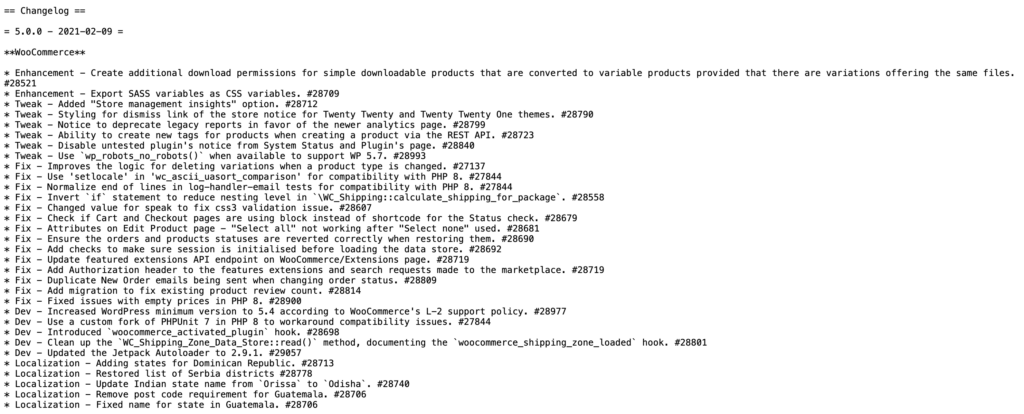
Understanding WooCommerce Changelogs: A Comprehensive Guide
WooCommerce is a powerful and versatile eCommerce solution that powers millions of online stores around the world.
To maintain its robust performance and security, WooCommerce regularly releases version updates and improvements, which are thoroughly documented in a “changelog.”
This guide will dive into the importance of using WooCommerce changelogs, how to interpret them, and best practices for putting them to use. Here’s what we’ll cover:
What is a WooCommerce changelog?
A WooCommerce changelog is a detailed record of all the updates, changes, bug fixes, and improvements made to a particular version of WooCommerce over time.
Each new release of WooCommerce is accompanied by a changelog that documents what has been modified or added in that specific version. The changelog also provides a chronological list of entries that typically includes the version number, release date, and a description of the changes implemented.

Changelog entries help developers, site administrators, and users understand the specific modifications in each update, ensuring compatibility with their existing setup and informing them about new features or resolved issues.
Changelogs serve as an essential reference for troubleshooting, maintaining site stability, and leveraging the latest advancements in the WooCommerce platform.
Importance of WooCommerce changelogs
WooCommerce changelogs are invaluable for eCommerce store owners and developers as they provide a transparent history of changes made and help you stay informed about updates that could impact your online store.
By reviewing changelogs, you can identify new features, improvements, and bug fixes that have been implemented, making it easier to take advantage of enhanced functionality and ensure your store operates smoothly.
Changelogs also serve as a crucial resource for troubleshooting. When issues arise, the detailed records in changelogs can help pinpoint when and where changes occurred, making it easier to identify potential causes of problems. This transparency fosters a proactive approach to maintenance and problem-solving.
Moreover, changelogs aid in compatibility checks. Before updating WooCommerce or installing new plugins, you can review the changelog to ensure there are no conflicts with your existing setup. This can prevent potential disruptions and maintain the stability of your online store.
Overall, WooCommerce changelogs are a great resource for maintaining an efficient, secure, and high-performing online store. The detailed insights they provide help users manage their store’s technical aspects with confidence and precision.

Benefits of using WooCommerce changelogs
WooCommerce changelogs offer a wealth of information that can significantly impact the management and optimization of your online store.
Understanding the following benefits can help you maximize these optimizations and unleash the full potential of your store.
Tracking updates and enhancements
WooCommerce changelogs allow users to track the enhancements and new features introduced in each version release, which helps store owners and developers leverage new functionalities and improve their store’s capabilities.
By staying informed about these updates, you can integrate advanced tools and features that keep your store competitive and aligned with the latest eCommerce trends.
Improving store performance and security
Regular updates to WooCommerce can include performance improvements and security patches. By following the changelog, users can ensure their store remains secure and performant.
Following this proactive approach also helps prevent vulnerabilities and exploits, providing a safer shopping environment for your customers and safeguarding your store’s data integrity.
Enhancing customer experience
By keeping up with the latest updates, store owners can implement new features that enhance their customer’s shopping experience.
This could include improved navigation, faster load times, and new functionalities that make shopping easier and more enjoyable. Enhanced customer experiences lead to higher satisfaction and retention rates, ultimately contributing to your store’s success.
Facilitating compliance and compatibility
Changelogs also play a crucial role in ensuring compliance with industry standards and compatibility with other tools and plugins.
By reviewing the changelog for a specific WooCommerce version, users can identify changes that may affect their current setup or compliance requirements. This allows for timely adjustments and ensures your store continues to operate smoothly without unexpected conflicts or regulatory issues.
Ultimately, WooCommerce changelogs are an important source of truth that can help store owners and developers maintain an efficient, secure, and high-performing online store.
How to access WooCommerce changelogs
Accessing WooCommerce changelogs is straightforward, and there are multiple sources where you can find detailed records of updates, changes, and improvements.
Here are the primary ways to access WooCommerce changelogs:
Official WooCommerce documentation
The official WooCommerce website is the primary source for accessing changelogs. Each release note is accompanied by a detailed changelog that outlines the modifications made in that version.
This is the most reliable and comprehensive source for understanding what changes have been made and how they might impact your store.
The WordPress plugin repository
The WordPress plugin repository also provides access to new versions of WooCommerce and its changelogs. Within the main WooCommerce page, there is a “Development” tab that details all the updates for that specific version and links to the full changelog for all WooCommerce versions.
This is a convenient source for users who manage their plugins through the WordPress dashboard, offering comprehensive information on the updates and changes made to WooCommerce.
GitHub repository
The WooCommerce GitHub repository is another valuable resource for accessing changelogs. GitHub provides detailed release notes for each version, including the changes, bug fixes, and enhancements.
This is especially useful for developers who want to see the code changes and commits associated with each update.
Third-Party resources
Several third-party websites and forums discuss WooCommerce updates and changelogs. These resources can provide additional context, user feedback, and community insights on the latest changes. Some notable third-party resources include:
In addition to official WooCommerce sources such as the Woo Developer Blog, these resources often feature discussions and analyses of the latest updates, helping you understand the practical implications of various changes.
By regularly checking these sources, you can stay informed about the latest developments in WooCommerce, ensuring your store remains up-to-date and fully optimized.

How to interpret WooCommerce changelogs
Interpreting WooCommerce changelogs is critical for understanding the updates, improvements, and fixes that have been made in each Woocommerce version release.
Here’s a detailed guide to help you make sense of the various inputs you’ll see in Woocommerce changelogs:
Understanding version numbers
WooCommerce uses a versioning system to identify each release. These version numbers typically follow the format X.Y.Z, where:
- X denotes a major release: This includes significant changes and possibly new features that could impact compatibility with themes and plugins.
- Y indicates a minor release: These are incremental improvements and additions that build on the major release.
- Z represents a patch or bug fix release: These address specific issues or bugs without adding new features or making major changes.
Understanding this versioning system helps users anticipate the impact of an update on their WooCommerce store.
Major releases (X) are more likely to require thorough testing and possibly adjustments to themes and plugins, while minor (Y) and patch (Z) releases are typically less disruptive but still important for maintaining optimal performance and security.
Here is an example of how these versioning numbers are used in practice:
- Version 4.0.0:
- Major release with significant changes.
- Introduced a new checkout flow and redesigned the admin dashboard.
- Potential compatibility issues with older themes or plugins.
- Version 4.1.0:
- Minor release with incremental improvements.
- Added support for additional payment gateways and enhanced reporting features.
- Builds on the major release without overhauling the system.
- Version 4.1.1:
- Patch release addressing specific bugs.
- Fixed an issue where product images were not displaying correctly.
- Resolved a security vulnerability related to user authentication.
With an understanding of these versioning conventions, store owners and developers can better manage updates and ensure their WooCommerce store remains compatible and secure.
Key elements in a changelog
A WooCommerce changelog usually contains several key elements, each serving a specific purpose:
- Version number: Identifies the specific release, helping users track the history and sequence of updates.
- Release date: Indicates when the version was released, which can be important for compliance and troubleshooting.
- Enhancements: Lists new features or improvements added to enhance the functionality of WooCommerce.
- Fixes: Details bug fixes and resolved issues, ensuring users know what problems have been addressed.
- Security: Notes any security vulnerabilities that have been addressed, which is critical for maintaining a secure online store.
- Developer Notes: Provides technical details or changes relevant to developers, such as deprecated functions or new hooks.
These elements collectively provide a comprehensive overview of what each release entails.
Real-world examples
To illustrate how a WooCommerce changelog is structured, here’s an example entry:
Version 5.8.0 – Released on October 12, 2021
- Enhancements:
- Introduced a new widget for displaying product reviews.
- Improved performance of the product query system.
- Fixes:
- Fixed an issue where product images were not displaying correctly on certain themes.
- Resolved a bug causing incorrect tax calculations under specific conditions.
- Security:
- Patched a vulnerability related to the checkout process.
- Developer Notes:
- Deprecated the wc_get_order function in favor of wc_get_order_object.
By breaking down the changelog into these sections, users can quickly identify what changes have been made and how they might affect their WooCommerce store. This structured approach to documentation ensures transparency and aids in effective store management.

Best practices for using WooCommerce changelogs
Using WooCommerce changelogs effectively can significantly improve the management and optimization of your online store.
By following best practices, you can ensure that your store remains secure, performs optimally, and leverages the latest WooCommerce features. Here are a few key recommendations:
Schedule regular reviews
To ensure your store remains up-to-date, schedule regular reviews of the WooCommerce changelogs. This practice helps you stay informed about new features, enhancements, and security patches that could impact your store.
Regular reviews can be scheduled monthly or in alignment with WooCommerce’s update release cycles, allowing you to proactively manage changes and updates.
Prepare for updates
Before applying updates, review the changelog to understand the changes and assess their impact on your store.
Testing updates in a staging environment can help identify potential issues before they affect your live site. This precautionary step ensures that your store continues to operate smoothly without unexpected disruptions or compatibility issues.
Communicate changes to your team
Ensure your team is aware of the updates and changes documented in the changelog. Clear communication helps in coordinating efforts to implement new features, fix issues, and maintain overall store performance.
Recurring team meetings or update briefings can be used to discuss the latest changes and plan for their implementation.
Keep documentation updated
Another best practice is to keep your internal documentation updated with information from the changelogs. This includes updating user manuals, training materials, and any internal guides that your team relies on.
By maintaining accurate documentation, you can ensure that your team has access to the most current information and best practices, facilitating smoother operations and quicker onboarding of new team members.
Adopting these best practices will help you maximize the benefits offered by WooCommerce changelogs and maintain a well-managed, secure, and high-performing online store.
Build your Woocommerce store with confidence
WooCommerce changelogs are a vital resource for maintaining and improving your online store. By understanding and utilizing changelogs effectively, you can ensure your store remains secure, performs optimally, and offers an enhanced shopping experience for your customers. Find out how you can push your WooCommerce store to new heights with WP Engine’s advanced eCommerce hosting. See features, plans and pricing here, or speak to a representative to learn more.
